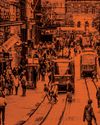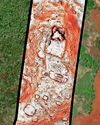
The climate chasm between the world's carbon-guzzling rich and the heat-vulnerable poor forms a symbolic shape when plotted on a graph. Climate-heating greenhouse gas emissions are so heavily concentrated among a rich minority that the image resembles one of those old-fashioned broad-bowled, saucer-shaped glasses beloved of the gilded age: a champagne coupe.
At the top is the wide, flat, shallow bowl of the richest 10% of humanity, whose carbon appetite through personal consumption, investment portfolios, and share of government subsidies and infrastructure benefits accounts for about 50% of all emissions.
Just below is the epicure, that narrowing joint of the glass where the dregs collect. This is made up of the middle 40%, whose carbon habit is roughly proportionate to its number but still double the average carbon budget that everyone would need to stick to if the world is to have any chance of avoiding more dangerous levels of climate breakdown.
Going further down is the long, slim stem comprising the remaining 50% of the world's population, whose carbon use tapers away along with incomes. At the bottom are the hundreds of millions who live in extreme poverty and barely register in terms of greenhouse gases.
The champagne coupe is a fitting image for the great carbon divide that we are living through. The last time wealth inequality was as pronounced as it is now was during that belle époque of the 1920s. Then, it was bad enough as a cause of social misery and international instability. Today, it is arguably much worse because the gulf between the haves and have-nots extends to their carbon emissions, which heightens suffering from the climate crisis and impedes efforts to find a solution.
This story is from the {{IssueName}} edition of {{MagazineName}}.
Start your 7-day Magzter GOLD free trial to access thousands of curated premium stories, and 9,000+ magazines and newspapers.
Already a subscriber ? Sign In
This story is from the {{IssueName}} edition of {{MagazineName}}.
Start your 7-day Magzter GOLD free trial to access thousands of curated premium stories, and 9,000+ magazines and newspapers.
Already a subscriber? Sign In

Finn family murals
The optimism that runs through Finnish artist Tove Jansson's Moomin stories also appears in her public works, now on show in a Helsinki exhibition

I hoped Finland would be a progressive dream.I've had to think again Mike Watson
Oulu is five hours north from Helsinki by train and a good deal colder and darker each winter than the Finnish capital. From November to March its 220,000 residents are lucky to see daylight for a couple of hours a day and temperatures can reach the minus 30s. However, this is not the reason I sense a darkening of the Finnish dream that brought me here six years ago.

A surplus of billionaires is destabilising our democracies Zoe Williams
The concept of \"elite overproduction\" was developed by social scientist Peter Turchin around the turn of this century to describe something specific: too many rich people for not enough rich-person jobs.

'What will people think? I don't care any more'
At 90, Alan Bennett has written a sex-fuelled novella set in a home for the elderly. He talks about mourning Maggie Smith, turning down a knighthood and what he makes of the new UK prime minister

I see you
What happens when people with acute psychosis meet the voices in their heads? A new clinical trial reveals some surprising results

Rumbled How Ali ran rings around apartheid, 50 years ago
Fifty years ago, in a corner of white South Africa, Muhammad Ali already seemed a miracle-maker.

Trudeau faces 'iceberg revolt'as calls grow for PM to quit
Justin Trudeau, who promised “sunny ways” as he won an election on a wave of public fatigue with an incumbent Conservative government, is now facing his darkest and most uncertain political moment as he attempts to defy the odds to win a rare fourth term.

Lost Maya city revealed through laser mapping
After swapping machetes and binoculars for computer screens and laser mapping, a team of researchers have discovered a lost Maya city containing temple pyramids, enclosed plazas and a reservoir which had been hidden for centuries by the Mexican jungle.

'A civil war' Gangs step up assault on capital
Armed fighters advance into neighbourhoods at the heart of Port-au-Prince as authorities try to restore order

Reality bites in the Himalayan 'kingdom of happiness'
High emigration and youth unemployment levels belie the mountain nation's global reputation for cheeriness